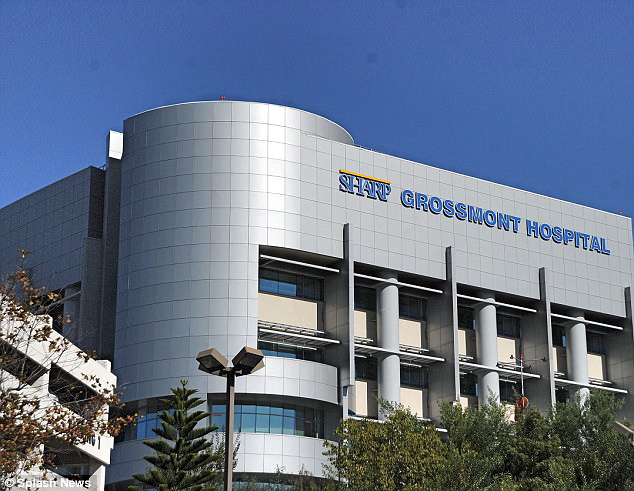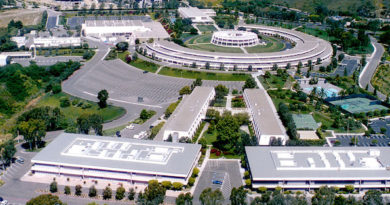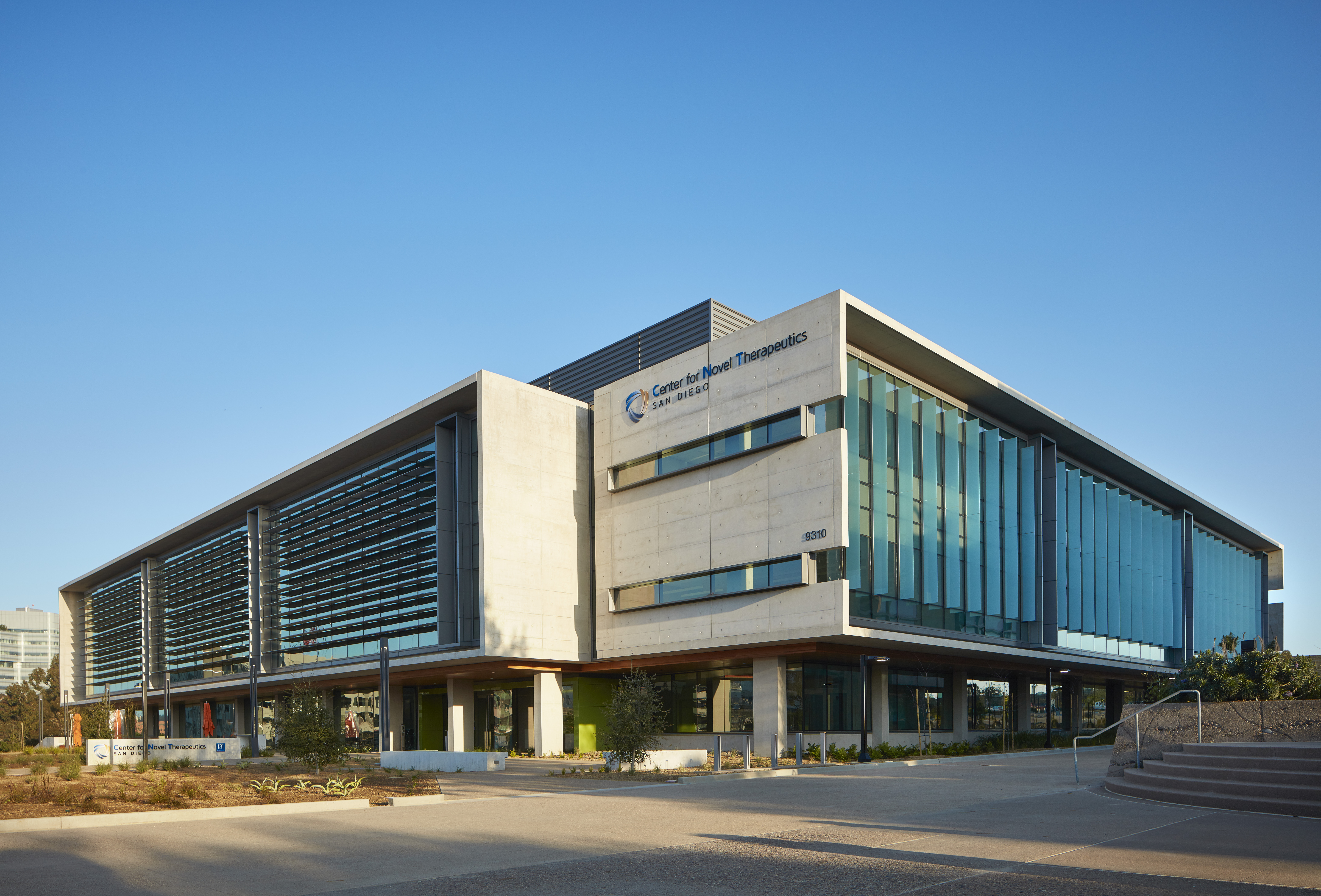Daily Business Report-May 1, 2015
Sharp Grossmont Hospital in La Mesa
Grossmont Healthcare District Board
To Consider Halting Construction Projects
A registered nurse on the Grossmont Healthcare District Board of Directors is questioning the financial health of construction projects at Grossmont Hospital under Proposition G, calling for a sudden halt to them.
Betty Stieringer, elected to the board in 2012, is worried about the program running out of money from the $247 million bond.
In a resolution to be considered at Monday morning’s board meeting, Stieringer calls on district CEO Barry Jantz to “partially terminate … any portion” of construction projects that can be halted.
Any work that can’t be stopped at the La Mesa hospital would be allowed to continue to completion. Some buildings with work to do might be “shelled,” or covered.
Among projects possibly at risk are the 71,000-square-foot Heart and Vascular Center, an 18,400-square-foot Central Energy Plant and improvements to the existing East Tower building, which dates to 1974.
“The project that would clearly be at risk with passage of the proposed resolution is the Surgery Floor Build-Out of the new Heart and Vascular Center,” district CEO Barry Jantz told Times of San Diego. He said the project is still left to bid.
“The bulk of our recent bond sale of $24 million in new funds will be used for the district’s portion of that work,” he said. “Sharp committed as part of last year’s lease extension to about $30 million for their portion of the work, about 50 percent of the overall project’s costs.”
Betty Stieringer’s resolution for the 7:30 a.m. meeting at district offices next to the hospital would bar new projects under Prop. G, approved by voters in June 2006 with a 77.7 percent “yes.”
— Times of San Diego
Read the full report here.

Champion Jockey Appoined to
California Horse Racing Board
Jockey Alex Solis, 51, of Solana Beach, has been appointed to the California Horse Racing Board by Gov. Jerry Brown.
Solis has been a jockey since 1982. He is a member of the Jockey’s Guild and was inducted into the National Racing Hall of Fame in 2014.
Solis is a native of Panama City. He got his big break and first gained national prominence when he won the 1986 Preakness Stakes with Snow Chief. On Jan. 1, he became the 29th jockey in North American history to have 5,000 wins — riding Lutine Belle at Santa Anita Park. The horse was owned partly by trainer Jerry Hollendorfer and part-owned by Solis’ son, Alex II.
The position requires Senate confirmation and the compensation is $100 per diem. Solis is a Democrat.
Union Group Calls Civic San Diego’s
Community Benefits Policy ‘A Farce’
The business manager of the San Diego County Building and Construction Trades Council on Thursday said that Civic San Diego’s recently adopted Community Benefits Policy is a “farce and a disgrace to our communities that deserve substance over fluffy promises.”
Tom Lemmon said the policy fails to include metrics for measurement of success, or provisions for accountability, enforcement, or oversight to ensure the delivery of quality community benefits to underserved neighborhoods.
“The policy governs all Community Benefits Agreements without taxpayer accountability and deprives the community of an opportunity to appeal the deal to the City Council. There is no other city in California that hands out public funds without direct oversight,” said Lemmon.
Lemmon said dozens of community groups advocated for a strong policy that delivers good-paying jobs, affordable housing and economic development as well as oversight provisions to strengthen community input and yield accountability over Civic San Diego. “Unfortunately, the adopted policy includes no specificity or metrics to measure success, and Civic San Diego has created a policy that leaves our communities with only good intentions and no accountability,” he said.
Civic San Diego recommends “local hiring,” but fails to provide a specific goal for local hiring, Lemmon said. Community groups advocated that “no less than 70 percent of a project’s work hours should be performed by San Diego County residents, and no less than 30 percent of a project’s work hours should be performed by residents in low-income areas of the city of San Diego.”
“Just like Civic San Diego itself, this policy lacks accountability and good, measurable community benefits,” said Lemmon.
SDG&E to Present $1.3 Million to Pala Indians
For Installation of Energy-Efficient Equipment
San Diego Gas & Electric on Monday will present a check for $1.3 million to the Pala Band of Mission Indians and the Pala Casino Spa & Resort for energy-efficient equipment to be installed in the nearly 630,000-square-foot property. It would be the largest on-bill financing loan to ever be issued in the state.
Principals at the presentation will include Caroline Winn, vice president of customer services for SDG&E, Robert Smith, tribal chairman of the Pala band, and Bill Bembenek, chief executive officer at Pala Casino Spa & Resort.
Pioneers Memorial Health Care District
Seeks Affiliation With Scripps Health
Pioneers Memorial Healthcare District’s Board of Directors has voted to pursue an affiliation arrangement with Scripps Health in San Diego to improve access to care for Imperial Valley residents. The parties anticipate that an agreement outlining the core services associated with the relationship will be finalized in the coming months.
Pioneers Memorial had sought expressions of interest from several major acute care providers on establishing an affiliation. The board chose Scripps Health.
“Our primary goal continues to focus on the quality of care available to residents and visitors in Imperial Valley,” said Catalina Alcantra-Santillan, president of the Pioneers Memorial board. “Our objective is to secure the highest quality and local availability of health care in our community. Through our work with Scripps, we expect to achieve that objective.”
Under the affiliation arrangement, Pioneers Medical would continue to run as an independent hospital.
New President Named for
San Diego Continuing Education

Carlos O. Turner Cortez has been named president of San Diego Continuing Education, the adult education division of the San Diego Community College District. Cortez’ appointment is scheduled to be ratified at the May 14 Board of Trustees meeting. He will begin his new role July 1.
The presidency of Continuing Education opened up last summer when its former president, Anthony Beebe, was named president of San Diego City College. Rudy Kastelic has served as interim president since Aug. 1.
Cortez comes to Continuing Education from Berkeley City College, where he has served as acting vice president of instruction and dean of Academic Pathways, Workforce Development, and Student Success.
San Diego Continuing Education serves 45,000 students per semester at seven campuses and many community locations.
Cortez also serves as an adjunct assistant professor at the Rossier School of Education at the University of Southern California, where he has worked in various capacities since 2001. His research interests center on the role of educators and administrators of color in the historical development of American social welfare and education policy.
SDG&E Joins Effort to Help Protect Nation’s Energy
Infrastructure Agains Bad Weather and Climate Change
San Diego Gas & Electric and 16 other utilities joined with the U.S. Department of Energy Thursday to launch a partnership to help protect the nation’s energy infrastructure against the impacts of extreme weather and climate change.
SDG&E will contribute its weather network, one of the largest and most sophisticated utility-owned systems in the U.S., and a web-based tool that classifies fire danger brought about by Santa Ana winds.
The Partnership for Energy Sector Climate Resilience was created in partnership with the U. S. Department of Agriculture, U.S. Forest Service and UCLA.
The Santa Ana Wildfire Threat Index, which includes four classification levels from “marginal” to “extreme,” will be used to help fire agencies, other first-responders and the public determine what actions to take based on the likelihood of a catastrophic wildfire breaking out, according to SDG&E.
“Collaboration between the public and private sectors will be vital to our nation’s preparedness for climate-related changes that could impact our country’s electric grid,” said Steven Davis, SDG&E’s president and chief operating officer. “The goal of this partnership is to identify the challenges our energy partners are facing today and how we can work together to develop some sustainable solutions.”
Energy Secretary Ernest Moniz and top executives from the utilities discussed how to accelerate investments in technologies, practices, and policies that will result in a resilient energy system.
— City News Service
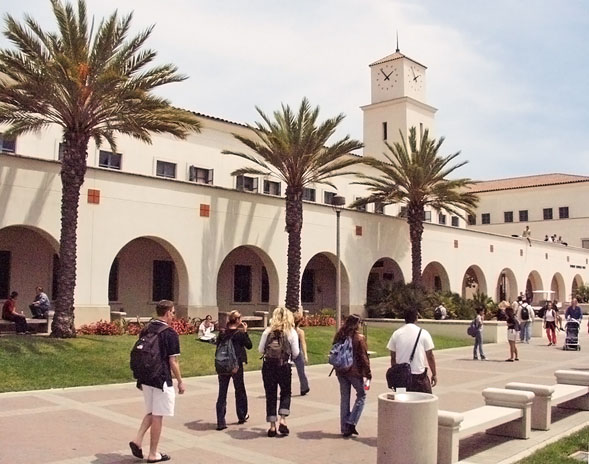
SDSU Launches Program to Aid
Students Facing Economic Problems
San Diego State University has launched an Economic Crisis Response Team, or ECRT, to better assist students who are facing an unexpected economic crisis.
The ECRT, which first met in October, includes faculty, staff, students and administrators from across campus who are working together to develop a plan to support SDSU students facing financial instability that could result in them being homeless or hungry.
“We have always supported students in need, but a formalized process to assist students in these types of situations has never been in place,” said Christy Samarkos, associate vice president for Campus Life. “As we noticed an increase in the number of students coming forward seeking help, we gathered a team to work on identifying all of the resources available to our students and establishing a process to help students access those resources.”
Resources and support
In addition to establishing a process for students to follow so they can receive support, the ECRT also:
• Works to more efficiently coordinate existing campus resources.
• Pinpoints off-campus resources available to students and their families
Determines the most effective way to communicate with students about available resources and processes.
• Plans programming and other forms of education to help students avoid financial crises in the future.
• Identifies areas of need for additional campus resources
“Our students find themselves in these situations for any number of reasons,” Samarkos said. “It can range from a parent losing their job and no longer being able to help with expenses, to students facing the costs of treating a serious illness to mismanagement of their financial aid funding.”
Help on and off campus
Existing on-campus resources include providing temporary housing and meal assistance; help with applying for and obtaining additional financial aid due to a change in financial status; assistance with finding on-campus employment; and social worker and/or counseling services.
Off-campus resources that have been identified include longer-term housing assistance, career assistance, counseling and crisis management support and application for longer-term state or federal assistance and access to health care.
Students who are in an unexpected economic crisis are encouraged to e-mail ecrt@mail.sdsu.edu or call (619) 594-1630.
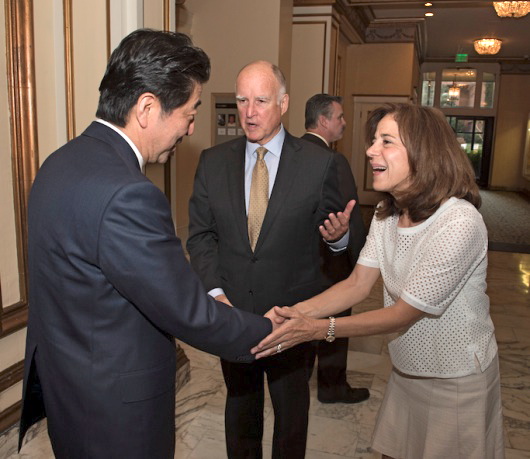
Gov. Brown Meets With Japan
Prime Minister Shinzo Abe
Governor Edmund G. Brown Jr. and First Lady Anne Gust Brown met with Prime Minister of Japan Shinzo Abe, First Lady of Japan Akie Abe and Japanese government officials Thursday night in San Francisco and later joined them at a dinner hosted by entrepreneur Ari Horie.
The governor and Prime Minister discussed a variety of subjects including climate change, high-speed rail and further strengthening California’s long-standing ties with Japan.
Last September, Brown signed an agreement with Japan’s Ambassador to the United States Kenichiro Sasae to further cooperation between Japan and California on climate change, renewable energy, trade and investment, zero-emission vehicles, high-speed rail and water.
The agreement calls for the two entities to collaborate on technologies that will support California’s goal of having 1.5 million zero-emission vehicles
on the road by 2025, as well as innovation related to high-speed rail, water conservation and renewable energy.

